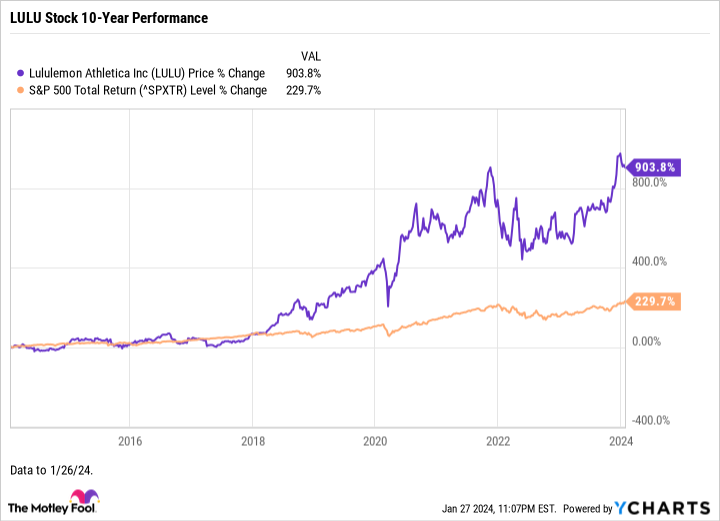Levi Strauss (LEVI 1.27%) stock eked out a 1.3% gain on Friday following the casual clothing retailer’s Thursday afternoon release of its results for the fourth quarter of fiscal 2023 (ended Nov. 26).
The quarter’s results were pretty much as expected. Revenue fell just slightly short of the Wall Street consensus estimate, but earnings narrowly surpassed it. Fiscal 2024 guidance, however, came in notably lighter than analysts had been projecting, stemming from weakness in the company’s wholesale business.
In response, management announced a restructuring plan to cut costs and accelerate the growth of the more profitable direct-to-consumer (DTC) business. The plan’s initial phase will include a layoff of 10% to 15% of the company’s global corporate workforce.
Following is an overview of Levi’s fourth quarter, along with its outlook, centered on four key metric categories.
1. Revenue grew 3.2%
Levi’s quarterly sales grew 3.2% (about 2% in constant currency) to $1.64 billion. This result fell a tad short of the $1.66 billion Wall Street consensus estimate. Below are the segment results.
| Segment | Fiscal Q4 2023 Revenue | Change (YOY) |
|---|---|---|
| Americas | $888 million | 6% |
| Europe | $379 million | 2% |
| Asia | $262 million | 4% |
| Other brands* | $113 million | (11%) |
| Total | $1.64 billion | 3.2% |
Data source: Levi Strauss. Fiscal Q4 2023 ended Nov. 26. YOY = year over year. *Other brands include Dockers and Beyond Yoga.
Within “other brands,” Beyond Yoga’s revenue jumped 14% as reported and in constant currency. However, Dockers dragged the category’s results down with its revenue drop of 18% (20% in constant currency). The brand, best known for its khaki pants and other “business casual” offerings, grew internationally and in the DTC channel but performed poorly in the U.S. wholesale business.
Levi’s wholesale channel’s sales fell 2% year over year (3% in constant currency) as low-single-digit percentage growth in the U.S. and Asia was more than offset by a 7% decline in Europe.
The company’s DTC channel’s sales increased 11% (10% in constant currency), driven by growth in the company-operated e-commerce business, where revenue jumped 19%, and in company-operated mainline and outlet stores. The DTC channel generated 42% of total revenue, up from 39% in the year-ago period.
2. Adjusted earnings per share (EPS) rose 29%
Net income under generally accepted accounting principles (GAAP) was $127 million, or $0.32 per share, down 16% year over year. Excluding one-time items, net income landed at $179 million, or $0.44 per share, up 29% year over year. This result edged by the $0.43 per share analysts had expected.
3. Operating cash flow nearly doubled in fiscal 2023
For the full fiscal year, Levi generated cash of $436 million running its operations, up 91% from fiscal 2022. The company ended the quarter with $399 million in cash and cash equivalents and $1 billion in long-term debt.
4. Fiscal 2024 revenue expected to grow 1% to 3%
For fiscal 2024, management guided for the following:
- Revenue growth of 1% to 3% year over year, which includes an expected 2-percentage-point negative impact primarily due to the company’s plans to exit its Denizen business (which offers lower-priced products), plans to place less emphasis on price-reduction sales, and foreign-currency headwinds.
- Adjusted EPS of $1.15 to $1.25, representing annual growth of 4.5% to 14%.
Going into Levi’s release, Wall Street had been modeling for fiscal 2024 revenue growth of 4.7% and adjusted EPS growth of 22%.
Data by YCharts.
Lululemon stock is a better bet within the apparel retailing industry
In short, Levi Strauss turned in a fairly decent quarter, but its fiscal 2024 outlook likely disappointed many investors. Reiterating what I wrote after Levi’s prior quarterly earnings release:
Many apparel retailers and other consumer discretionary companies are facing challenging market conditions, driven by high interest rates and inflation…. So it’s particularly important for investors to only consider buying shares of the strongest companies in their respective industries.
In the apparel retailing space, athletic-wear specialist Lululemon Athletica is such a company. Along with its emphasis on performance fabrics, its positioning as a higher-end brand is a plus in the current environment because higher-income folks usually weather tough macro conditions better than others.
Indeed, since I wrote those words on Oct. 6, 2023, Lululemon shares have returned 30.2% through Jan. 26. Levi shares and the S&P 500 have returned 21.8% and 14%, respectively, over this period. More importantly, Lululemon stock has performed wonderfully over the long term. However, since its March 2019 initial public offering, Levi’s stock has declined. There seem to be no good reasons this performance disparity won’t continue.
Beth McKenna has no position in any of the stocks mentioned. The Motley Fool has positions in and recommends Lululemon Athletica. The Motley Fool has a disclosure policy.




